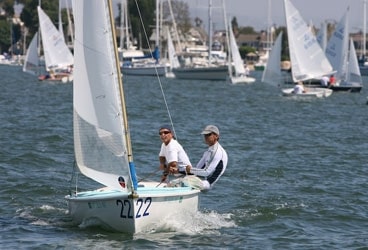
FBGaudio368
Like the Lido 14 Class in which he has enjoyed so much success, Mark Gaudio is a product and fixture of the Newport Beach, Calif., racing scene. Both the boat–designed by Barney Lehman and Bill Schock–and the sailor turned 50 this year, so it was only fitting that when the class held its anniversary championship at Newport Harbor YC last August, Gaudio was the winner. It was Gaudio’s fourth time winning the event in the past eight years and his second major victory in as many weeks; he took top honors at the Cal 20 North American Championships the weekend before.Gaudio permeates small boat racing in Southern California. He runs Vanguard Sailing Center of Southern California, coaches junior racing teams at Coronado YC and Alamitos Bay YC, holds racing clinics throughout the region, and, in addition to Lido 14s and Cal 20s, races Lasers, Naples Sabots, and Harbor 20s.He’s a charismatic advocate for the sport and a generous teacher, but also a fierce competitor who’s not afraid to play hardball. At the 2007 Lido 14 Class Championship, Gaudio had no qualms about blowing the whistle on a competitor who was racing with an illegal transom. “I’ll be as fierce as the next guy out on the racecourse,” he says. “You can sail hard, but not against the spirit of the rules. The Lido 14 has a long history of decent, competitive sailors, meat-and-potato people.”
You’ve done some winning on Newport Harbor. Care to share any local knowledge?
There are three phases of wind in Newport. In the southerly phase you want to pay attention to the left side of the course. When it’s blowing from the southwest, you basically want to connect the dots of pressure. The will be just as many changes in pressure as changes in direction, and when it’s doing both, there’s bound to be a hole where the puff just was. In a westerly, basically you want to protect the right side of the course.
What did you learn at the 2007 Lido 14 Class Championship?
You know what I learned, or should I say, relearned? The Holy Grail is still getting your bow out and hitting the first shift. I tell the kids that: Don’t worry about your equipment. What matters most is getting your bow out and hitting the first shift.
What is your lasting memory of Roy Woolsey (90-year old Lido 14 legend who passed away shortly after racing in the 2007 Class Championships)?
He had a real zest for life. He was a gentleman on and off the water. He called Vanguard a few months ago looking to buy a new Laser centerboard– his wasn’t going fast enough, apparently. He was still very competitive in that way, always wanting to go as fast as possible, even in his 90s.
What did you do to prepare for the event?
No much, really. My crew, Dave Swain, and I sailed a few nights of the Balboa YC Wednesday night series, which is sort of like jungle ball out here. We went out, practiced one roll tack, nailed it, and were like, “We’re done.”
Who was your toughest competition at the event?
Stu Robinson, without a doubt. Between he and I it was full metal jacket man to man combat every race. We were sprung out by a minute on everyone else a lot of the time. He won two in a row where he jumped out and caught a couple shifts. I won three in a row. One race we had a 20-roll-tack covering fest.
Any advice for racing through a mooring field?
Well, you definitely don’t want to hit a moored boat while you’re doing a 720. One guy did that at the Lidos. First and foremost, don’t hit anything. Second, you can thread the needle and use moored boats in a pick and roll situation. Third, there are lanes where it’s more open between boats, and you want to find one of these unobstructed lanes. If you’re in the front row, it’s like being in a candy store– you can pick a Hersheys or a Snickers or whatever you want. Later in the race your choices are going to be more limited. Downwind is more challenging. If it’s a light breeze, look for the next pressure to come from the next open lane. If you’re reaching, you might want to jibe into another lane for more pressure. And of course all the normal obstruction rules apply, so keep that in mind when you’re asking for room to tack. It can get pretty competitive, and you’ll hear a lot of pissing and moaning from the middle of the fleet.









